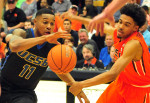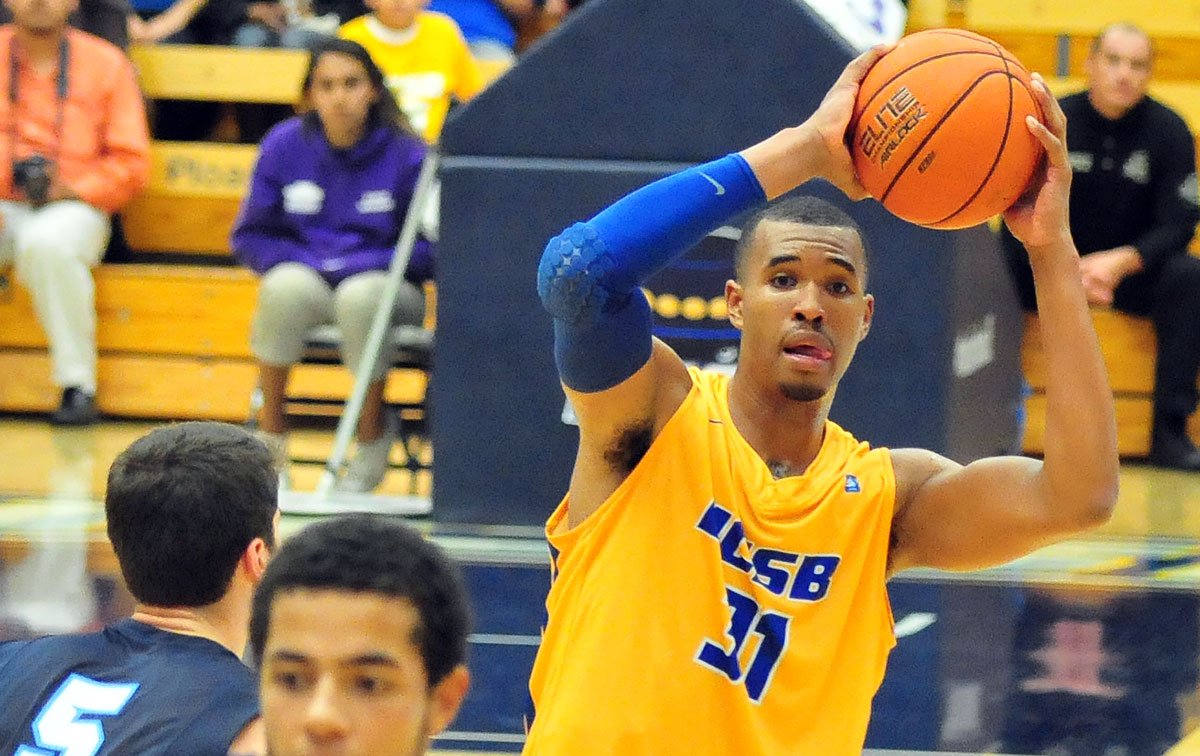
UCSB’s John Green has played 21 games this season after totaling just three games in his first three years at UCSB. (Presidio Sports Photos)
With 2:25 left on the clock during UCSB’s last game, what ended in a thrilling 75-74 triumph over Hawaii, Gaucho guard John Green sunk a 3-pointer from the corner to tie the game at 70. The Thunderdome stayed true to its nickname, as the Gaucho fans roared into a frenzy.
It was an explosion of applause directed his way that Green was finally experiencing after three tough years of one injury after another.
Green and the Gauchos, who trailed for nearly the entire game, would go on to complete a 13-point rally and stun the Rainbow Warriors in a nationally televised Big West showdown. They dug deep within themselves to pull off a comeback for the ages.
For Green, however, comebacks are all too familiar. In fact, one could say that overcoming adversity has almost become routine for the Oakland native.
UPCOMING UCSB HOME GAMES:
- Thursday, February 12 – Long Beach State, 7:30 p.m.
- Thursday, February 26 – UC Davis, 7 p.m.
- Saturday, February 28 – UC Irvine, 9 p.m.
- Saturday, March 7 – Cal Poly, 3 p.m.
“It’s hard for me to put into words just how happy I am that John is finally getting the opportunity to play at UCSB,” says UCSB head coach Bob Williams, who recruited Green way back in 2010. “The road has been a long one and he kept his head up, now he’s reaping the rewards.”
The injury trouble started before Green even arrived at UCSB, in the summer of 2011. He came into summer training with a fractured right foot, and was bound to a walking boot until his injury healed. After his foot injury healed, Green saw his first action in an early exhibition game.
“The crowd and the fans were really excited because I had a very good exhibition game,” says Green.
However, the excitement was short-lived. A few weeks later, Green was faced with another challenge: another fracture, this time in his left foot. The injury would require surgery and a screw placed in his foot, keeping Green out for another three months.
Green was able to return in February of 2012, but was limited to scout team duties for the rest of the season.
With the 2012-2013 basketball season came a fresh slate and an optimistic outlook, but the powers that be in the world of athletics thought otherwise. In an open gym practice near the end of the 2012 summer, Green planted on his left foot while executing a routine layup.
A “pop” sound — the very sound that makes athletic trainers gasp with concern — was heard while Green pushed off his foot.
Green couldn’t believe it.
“The whole time I was thinking, ‘this can’t be happening again’,” Green recounts.
X-rays revealed that the left foot had indeed been fractured again. The amount of force that Green exerted while planting was so strong that the pin in his left foot had also snapped in half.
A major surgery conducted in Santa Monica would yet again keep Green off the court for the remainder of the year.
For many athletes, a major surgery would signify the end of their athletic careers. Rehabbing, watching from the sidelines, and still maintaining a time commitment to the team is a tall order, which few are ever blamed for backing out of. For John Green, his passion is what has fueled his perseverance.
“When you love something, you don’t quit on it,” Green says, with a gaze that refuses to ask for sympathy. “And I really love the game of basketball.”
While keeping up with his physical rehab, Green was able to finally complete a summer training stretch in 2013. Before the first exhibition game of the season, the nagging foot pain would rear its ugly head once again.
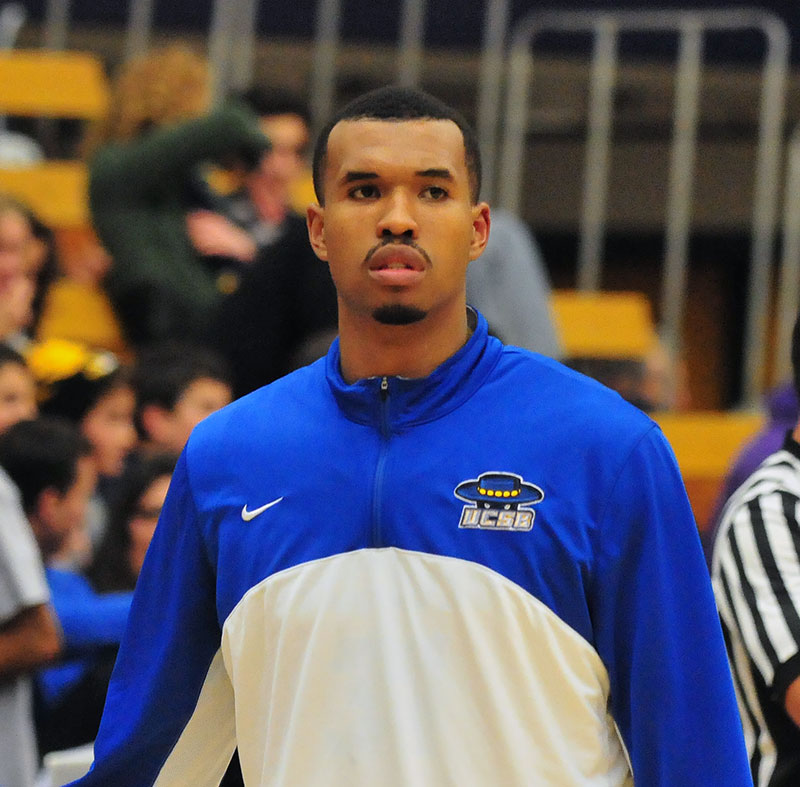
Green is averaging 11 points per game this season in 23 minutes.
Green, avoiding the common athlete error of keeping pain secret, wisely notified his coaches.
“I felt something funny in my foot, and I told coach that my foot had been feeling a little funny.” Green would get more X-rays after the Gauchos’ first exhibition game, and continued to play through the discomfort for a few more weeks.
Despite his pain, Green was fully prepared to participate in a November match-up against UNLV in 2013. The game would be the latest in a historic series between the two teams, which includes the Gauchos’ upset over the would-be national champion Rebels in 1990 and a double-overtime thriller in 2011.
Shortly before the game, however, Green was called into coach Williams’ hotel room. Williams notified Green that the X-rays had come back positive, and that another area of is foot had a minor fracture.
Green and the Gaucho coaching staff had caught the injury in time to prevent it from becoming season ending. Green would be scheduled to return when the Gauchos began conference play.
On February 1st, 2014 against UC Davis, Green made his first-ever appearance in a regular-season game as a Gaucho. He scored only two points during the game, but they were two points that validated all of Green’s hard work.
“It felt good to be able to come back and play an official Division-1 basketball game,” Green recalls. “I officially became a Divison-1 basketball player that day.”
While the bad luck that had plagued Green’s legs appeared to have finally gone away, it apparently had just transferred to another limb. After a team practice, the injury bug bit Green for an astounding fifth time, as he suffered a scaphoid fracture.
“Next thing you know, I fractured my wrist. From there, I was out for the rest of the year.”
Understandably this wrist injury seemed to be the one that finally got to the ever-optimistic Green.
“That injury was probably the worst that really put me down, and put my spirits down,” says Green.
However, the dampened spirit wouldn’t last long. Green was now aided by a familiarity with setbacks, and a long-standing relationship with adversity.
“I told myself, ‘Alright. We’ve overcome three foot injuries, one wrist injury, but it’s still not time to give up’,” says Green.
To Green, quitting because of an injury was completely out of the question.
“I was raised not to be a quitter,” says Green. “If you’re going to quit on something, then there must be a legitimate reason.”
While Green refuses to name his injuries as a valid reason to give up, he doesn’t hesitate to name what has helped him to persevere through his obstacles.
One of his main sources of motivation is his sister, who, despite suffering from paranoid-schizophrenia, has refused to feel sorry for herself.
“She keeps on smiling though what she deals with,” Green says. “She doesn’t let anybody keep her spirits down. If she can deal with what she goes through on a daily basis, then why not stick through and have a positive mindset?”
Green says he tried to match his sister’s optimism while dealing with his injuries. “That really made me stay focused to get back on the court and do the thing I love to do,” he says.
While Green has been motivated by the bravery of his sister, he has also been driven by the bond he has with his brothers on the court — namely fellow ’11 recruits T.J. Taylor and Alan Williams.
“We’re all like brothers,” Green says. “We’re going to know each other for the rest of our lives.”
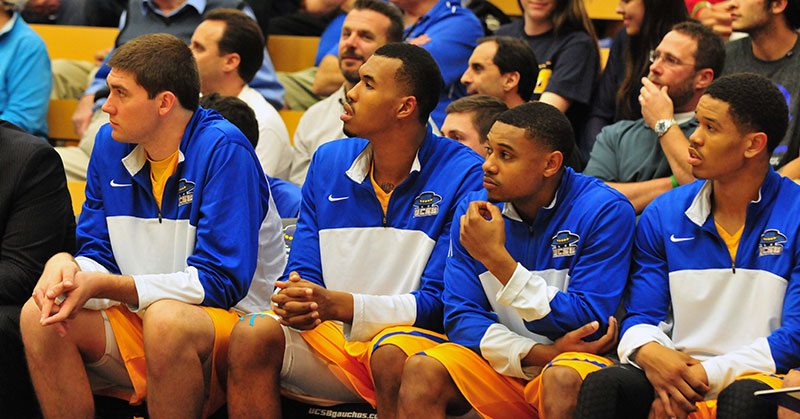
Green, sitting second to left between Sam Beeler and TJ Taylor with Eric Childress on the far right, is relishing the opportunity to contribute to the team this year.
Green had encountered Taylor before in high school, both players being star recruits in the Oakland area. In fact, Taylor committing to UCSB made the decision that much easier for Green.
“T.J. coming here was one of the reasons why I came here,” Green says. “We’re from the same city, played in the same club organization, and came on the same recruiting trip. It was basically his job to recruit me here.”
Green had also become familiar with Alan Williams during an elite camp held at the University of Arizona. Once Green and Williams had both committed at the same time, a lifelong friendship was born.
“It was like ‘jackpot’ I’m with two good guys that I know pretty well,” Green recounts.
Since day one, the three have made a commitment to one another, and have pushed through adversity together.
This was the season when it seemed like the three would finally be able to pursue a Big West championship together, but fate struck again. Alan “Big Al” Williams, a 2014 AP All-American honorable mention, injured his left shoulder.
The injury would rule Williams out for at least two weeks. The Gauchos, a nervous 1-2 at the time, would have to take on UC Riverside without their featured player.
Green, unfazed by the pressure of playing without Williams, summed up the situation in one statement: “I needed to step up. We all needed to step up.”
Green’s version of stepping up was a career high 21-point effort en route to an 83-75 Gaucho victory.
“I think that that over the rest of his career, he will only get better and better,” Bob Williams says. “What we’re seeing right now with John is just the tip of the iceberg and it’s very exciting.”
Green’s encore performance, a double-double against Cal State Fullerton, helped the Gauchos outscore Fullerton 19-0 in the second half and claim a 68-49 win. The win was not only without Williams, but also without regular contributor DeJuan Smith and upstart freshman Gabe Vincent.
“Those were two crazy games for me,” Green says, understating his performances. “I felt good that weekend, and we couldn’t allow those two teams to come beat us at home.”
For Green and company, it’s all about winning key games while Williams heals.
“It’s to create more breathing room for him when he comes back. We don’t want to put too much pressure on him when he returns.” The win over Hawaii puts the Gauchos at a solid 4-4, and things are looking up with Big Al slated to return soon. The Gauchos have eight conference games remaining starting with Thursday night’s game at home against Long Beach State.
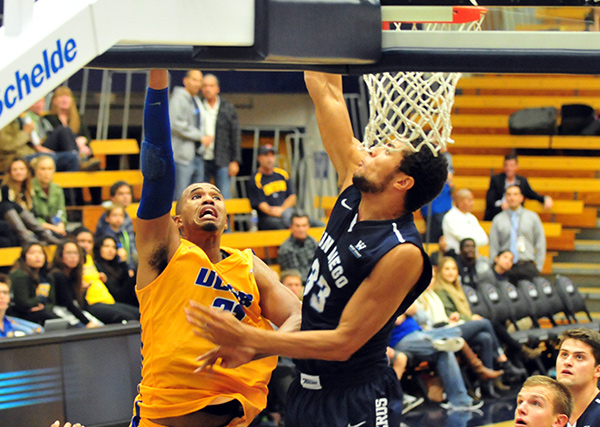
Green can score at the rim or from range with his jump shot.
With the way Green describes his experiences up to this point, it seems as though the injury trouble had never happened. He is almost always smiling, and gives off a positive vibe. There is no self-pity in his words, and he insists on speaking of what he has learned from his struggles, instead of what he lost.
“One door closes, but many of them open for you”, Green says. “Maybe those injuries meant something.”
Green, who is closing in on completing his anthropology degree, plans to work towards graduate school next year.
Green would also like for his story to be used as a teaching tool for players facing struggles in the future. “I wanted to be a living testimony to other athletes, that if I can make and push through all these injury obstacles, then you can do it too,” Green says.
Although the road for Green has gone in many different directions and phases, the one constant has been his hard-earned resolve. It is the same resolve that he wants people to think of whenever his story is brought up.
“I just want to make sure that people don’t feel too sorry for me,” Green says.
After the Hawaii game, which had a season-high attendance of 4,383, the thundering cheers of the crowd — three years in the making — sounded anything but sorry.

